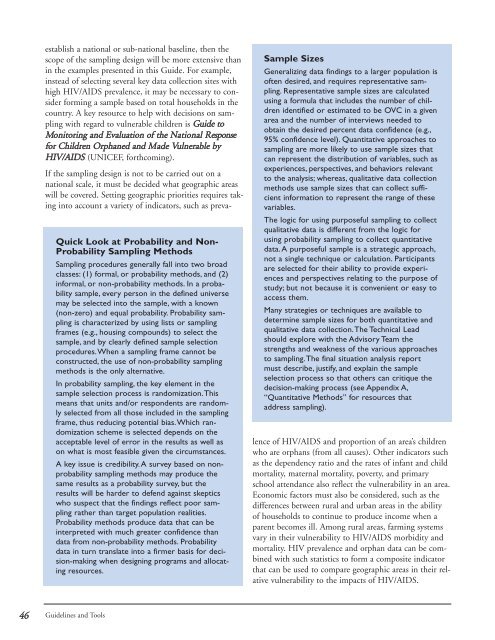Conducting a Participatory Situation Analysis of.pdf - Global HIV ...
Conducting a Participatory Situation Analysis of.pdf - Global HIV ...
Conducting a Participatory Situation Analysis of.pdf - Global HIV ...
Create successful ePaper yourself
Turn your PDF publications into a flip-book with our unique Google optimized e-Paper software.
establish a national or sub-national baseline, then the<br />
scope <strong>of</strong> the sampling design will be more extensive than<br />
in the examples presented in this Guide. For example,<br />
instead <strong>of</strong> selecting several key data collection sites with<br />
high <strong>HIV</strong>/AIDS prevalence, it may be necessary to consider<br />
forming a sample based on total households in the<br />
country. A key resource to help with decisions on sampling<br />
with regard to vulnerable children is Guide to<br />
Monitoring and Evaluation <strong>of</strong> the National Response<br />
for Children Orphaned and Made Vulnerable by<br />
<strong>HIV</strong>/AIDS (UNICEF, forthcoming).<br />
Quick Look at Probability and Non-<br />
Probability Sampling Methods<br />
Sampling procedures generally fall into two broad<br />
classes: (1) formal, or probability methods, and (2)<br />
informal, or non-probability methods. In a probability<br />
sample, every person in the defined universe<br />
may be selected into the sample, with a known<br />
(non-zero) and equal probability. Probability sampling<br />
is characterized by using lists or sampling<br />
frames (e.g., housing compounds) to select the<br />
sample, and by clearly defined sample selection<br />
procedures.When a sampling frame cannot be<br />
constructed, the use <strong>of</strong> non-probability sampling<br />
methods is the only alternative.<br />
In probability sampling, the key element in the<br />
sample selection process is randomization.This<br />
means that units and/or respondents are randomly<br />
selected from all those included in the sampling<br />
frame, thus reducing potential bias.Which randomization<br />
scheme is selected depends on the<br />
acceptable level <strong>of</strong> error in the results as well as<br />
on what is most feasible given the circumstances.<br />
A key issue is credibility.A survey based on nonprobability<br />
sampling methods may produce the<br />
same results as a probability survey, but the<br />
results will be harder to defend against skeptics<br />
who suspect that the findings reflect poor sampling<br />
rather than target population realities.<br />
Probability methods produce data that can be<br />
interpreted with much greater confidence than<br />
data from non-probability methods. Probability<br />
data in turn translate into a firmer basis for decision-making<br />
when designing programs and allocating<br />
resources.<br />
Sample Sizes<br />
Generalizing data findings to a larger population is<br />
<strong>of</strong>ten desired, and requires representative sampling.<br />
Representative sample sizes are calculated<br />
using a formula that includes the number <strong>of</strong> children<br />
identified or estimated to be OVC in a given<br />
area and the number <strong>of</strong> interviews needed to<br />
obtain the desired percent data confidence (e.g.,<br />
95% confidence level). Quantitative approaches to<br />
sampling are more likely to use sample sizes that<br />
can represent the distribution <strong>of</strong> variables, such as<br />
experiences, perspectives, and behaviors relevant<br />
to the analysis; whereas, qualitative data collection<br />
methods use sample sizes that can collect sufficient<br />
information to represent the range <strong>of</strong> these<br />
variables.<br />
The logic for using purposeful sampling to collect<br />
qualitative data is different from the logic for<br />
using probability sampling to collect quantitative<br />
data.A purposeful sample is a strategic approach,<br />
not a single technique or calculation. Participants<br />
are selected for their ability to provide experiences<br />
and perspectives relating to the purpose <strong>of</strong><br />
study; but not because it is convenient or easy to<br />
access them.<br />
Many strategies or techniques are available to<br />
determine sample sizes for both quantitative and<br />
qualitative data collection.The Technical Lead<br />
should explore with the Advisory Team the<br />
strengths and weakness <strong>of</strong> the various approaches<br />
to sampling.The final situation analysis report<br />
must describe, justify, and explain the sample<br />
selection process so that others can critique the<br />
decision-making process (see Appendix A,<br />
“Quantitative Methods” for resources that<br />
address sampling).<br />
If the sampling design is not to be carried out on a<br />
national scale, it must be decided what geographic areas<br />
will be covered. Setting geographic priorities requires taking<br />
into account a variety <strong>of</strong> indicators, such as prevalence<br />
<strong>of</strong> <strong>HIV</strong>/AIDS and proportion <strong>of</strong> an area’s children<br />
who are orphans (from all causes). Other indicators such<br />
as the dependency ratio and the rates <strong>of</strong> infant and child<br />
mortality, maternal mortality, poverty, and primary<br />
school attendance also reflect the vulnerability in an area.<br />
Economic factors must also be considered, such as the<br />
differences between rural and urban areas in the ability<br />
<strong>of</strong> households to continue to produce income when a<br />
parent becomes ill. Among rural areas, farming systems<br />
vary in their vulnerability to <strong>HIV</strong>/AIDS morbidity and<br />
mortality. <strong>HIV</strong> prevalence and orphan data can be combined<br />
with such statistics to form a composite indicator<br />
that can be used to compare geographic areas in their relative<br />
vulnerability to the impacts <strong>of</strong> <strong>HIV</strong>/AIDS.<br />
46<br />
Guidelines and Tools















